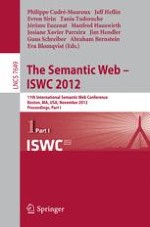The two-volume set LNCS 7649 + 7650 constitutes the refereed proceedings of the 11th International Semantic Web Conference, ISWC 2012, held in Boston, MA, USA, in November 2012. The International Semantic Web Conference is the premier forum for Semantic Web research, where cutting edge scientific results and technological innovations are presented, where problems and solutions are discussed, and where the future of this vision is being developed. It brings together specialists in fields such as artificial intelligence, databases, social networks, distributed computing, Web engineering, information systems, human-computer interaction, natural language processing, and the social sciences. Volume 1 contains a total of 41 papers which were presented in the research track. They were carefully reviewed and selected from 186 submissions. Volume 2 contains 17 papers from the in-use track which were accepted from 77 submissions. In addition, it presents 8 contributions to the evaluations and experiments track and 7 long papers and 8 short papers of the doctoral consortium.
